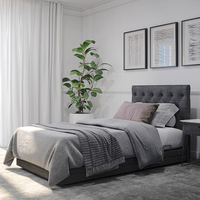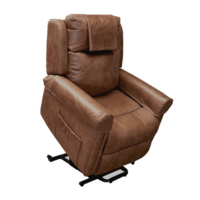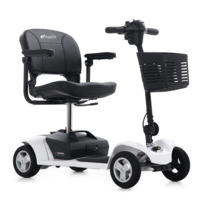Guide To Shower Commodes for Seniors
Bathing and other bathroom tasks can present serious challenges for seniors with limited mobility. The combination of a small space and wet surfaces can lead to injury-inducing slips and falls. However, there are ways to help reduce the risks associated with bathroom use for seniors.
Mobility and safety aids can be particularly beneficial in ensuring safety and comfort in the bathroom. A shower commode, for example, can help seniors to bathe safety as well as use the toilet with ease. In this guide, we discuss more shower commodes, including their benefits and how they are used.
What is a shower commode?
A shower commode is a chair that features an open seat that can be used in the shower or positioned over the toilet. They are designed to assist those who have difficulties using the toilet or standing for extended periods of time in the shower.
Many shower commodes feature wheels, which decrease the number of transfers required for bathroom tasks and improve safety.
The seats of shower commodes are made from hygienic materials, which can be wiped clean, and typically feature padding for comfort. The open seat can come in a variety of different cut-out shapes depending on the user’s needs and as recommended by a therapist.
Many shower commodes can also be fitted with a pan for use as a standalone commode. Others feature moveable arms, which can be adjusted to make transfers in and out of the chair simpler.
Different types of shower commodes
As with all mobility and safety aids, shower commodes are available in a variety of options. There are standard shower commodes, attendant-propelled wheeled shower commodes, self-propelled wheeled shower commodes, and tilt-in-space shower commodes, which have recline capabilities.
Wheeled shower commodes can aid seniors who have difficulty walking to and from the shower and toilet. They can be maneuvered by a carer or may be self-propelled, depending on their style. Attendant-propelled commodes include handles for an assistant to push the user while self-propelled commodes feature large wheels to allow the user to move around the bathroom.
In addition to reducing the risk of slips and falls in the bathroom, self-propelled shower commodes can also provide independence to seniors and help maintain their dignity.
When selecting a shower commode, it’s important to consider the design along with the style. High-quality ergonomic options can provide unparalleled comfort and support in a variety of positions.
How a shower commode can aid seniors
As bathrooms can be particularly dangerous due to their hard and slippery surfaces, having the aid of a shower commode can provide a measure of safety. Ideal for reducing the risk of falls and slips, shower commodes can offer support for those who struggle to stand in the shower and make using the toilet easier. Additionally, wheeled shower commodes can also make transfers and move to and from, as well as in, the bathroom easier.
Another benefit of shower commodes is that they can help to promote personal hygiene in seniors. As using the bathroom can become challenging and more dangerous with age, many seniors lose their confidence in their capabilities and subsequently sacrifice their personal hygiene to remain safe. With a shower commode, however, the risks of using the bathroom are significantly reduced, allowing seniors to once again feel confident using the space.
How to safely use a shower commode
To safely use the shower commode, it’s important to ensure that the user is comfortable getting into and out of it, whether assisted or not.
Preparation is an important step no matter what mobility assistance you or your loved one use. First, ensure that you are feeling ready for the tasks you are about to carry out. Have all the things you need – such as clean towels, soap and a change of clothes – ready and at hand. A dressing gown or lose slip will help to maintain modesty while being easy to remove before entering the shower.
Lower yourself or your loved one onto the shower commode and then undertake bathroom tasks as usual. It’s important to move calmly and with purpose between tasks. If possible, lock the wheels of your shower commode in place while carrying out tasks to keep the chair in place.
After doing everything you need to, exit the bathroom and transfer to another chair or bed. Finally, the commode should be dried following use and stored in a dry environment.
Shower commode care and maintenance
Proper care and maintenance of any mobility aids you use are essential. Wipe down the chair after use, especially under the seat for hygienic reasons and to prolong its life. Additionally, wheels should be cleaned to ensure they are not obstructed by anything, such as hair or dirt.
Because shower commodes come in contact with water, you should regularly check for signs of wear and tear. Look for signs of rust or mould, particularly around moving parts; ensure the brakes work; and make sure that any swing away parts move freely and lock into position with ease. You should also check for any splits or breakages in the polyurethane fabric.
To find the right shower commode for your needs, browse the Mobility HQ range online.



































